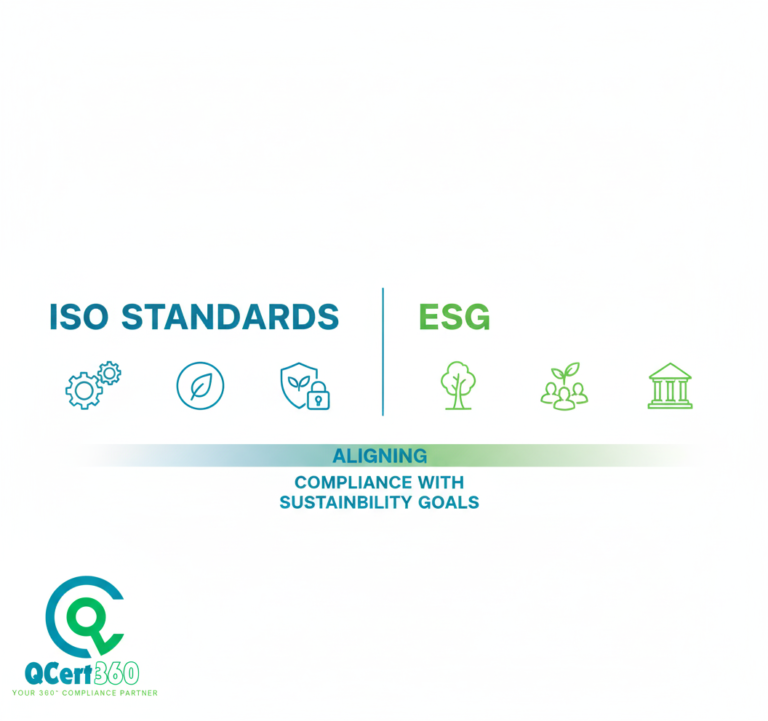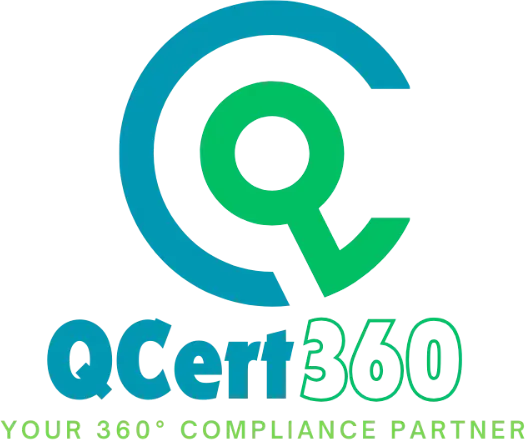
If you’ve been paying attention to business trends, you’ve probably noticed how Environmental, Social, and Governance (ESG) goals are reshaping the way organizations operate. At the same time, ISO standards remain the backbone of global compliance, offering a framework for quality, safety, and sustainability. The real opportunity lies in connecting these two worlds—using ISO certifications to demonstrate that ESG commitments aren’t just words on paper but embedded in everyday business practices.
Let’s break it down.
Why ESG and ISO Standards Belong Together
ESG is about more than producing sustainability reports—it’s about demonstrating that your business is responsible, ethical, and future-ready in a measurable way. At the same time, ISO standards provide the structured processes, recognized frameworks, and independent third-party validation needed to make those ESG claims credible and verifiable.
Take a closer look:
• ISO 14001 helps companies manage and reduce their environmental impact, directly reinforcing the “E” in ESG by showing clear evidence of sustainable operations.
• ISO 45001 ensures workplace safety and employee well-being, which perfectly aligns with the “S” in ESG by addressing social responsibility.
• ISO 37001 tackles anti-bribery and corruption, giving organizations a practical way to strengthen their governance systems and support the “G” in ESG.
In regions such as the EU, UAE, and Africa, tendering authorities, regulators, and investors are no longer satisfied with broad promises. They increasingly expect ESG accountability backed by certifications. This is where ISO certification becomes a powerful tool: integrating ISO standards into your ESG framework not only builds stakeholder trust but also accelerates qualification for contracts, public tenders, and cross-border approvals.
The ESG Reporting Pressure
Governments and investors are increasingly asking for ESG disclosures, putting companies under real pressure to show how they manage sustainability. In the EU, regulations such as the Corporate Sustainability Reporting Directive (CSRD) require businesses to provide detailed information on their environmental and social performance, not just financial results. A similar momentum can be seen in the UAE’s Vision 2031 sustainability targets, which emphasize sustainable growth, green initiatives, and accountability from companies operating in the region. African markets are also moving in the same direction, with policies that push for greener supply chains and more transparent reporting practices.
Here’s the thing: most organizations don’t have to reinvent the wheel to meet these requirements. ISO standards already provide a credible framework to collect, track, and report ESG data in a structured way. Whether it’s environmental management through ISO 14001 or social responsibility with ISO 26000, these standards give businesses a globally recognized system they can trust. That’s why ISO certification for ESG compliance is quickly becoming one of the fastest-growing areas of demand in Europe, the Middle East, and Africa.
Key ISO Standards That Strengthen ESG
Here’s how specific ISO standards connect directly with ESG dimensions and give organizations a practical way to move from promises to measurable actions:
- Environmental (E)
- ISO 14001 – Environmental Management Systems: Provides a clear framework for waste reduction, pollution prevention, energy efficiency, and compliance with green regulations. For companies operating in regions with strict oversight like the EU, ISO 14001 is often the baseline proof of environmental accountability.
- ISO 50001 – Energy Management: Goes beyond compliance by helping organizations systematically optimize energy consumption. This not only lowers costs but also cuts emissions, making it a strong tool for meeting carbon neutrality goals or regional climate commitments.
- Social (S)
- ISO 45001 – Occupational Health & Safety: Reduces workplace risks and creates a culture of safety, which directly supports employee wellbeing and productivity. In sectors like construction, healthcare, and manufacturing, ISO 45001 certification has become a critical part of ESG reporting.
- ISO 26000 – Social Responsibility: Offers practical guidance on fair business practices, respect for human rights, diversity, and community involvement. While it’s not a certifiable standard, it helps companies align with stakeholder expectations around social impact.
- SA 8000 – Social Accountability: Specifically targets labor rights, working conditions, and fair treatment across supply chains. For global exporters, SA 8000 certification signals to partners and regulators that social sustainability is being taken seriously.
- Governance (G)
- ISO 37001 – Anti-bribery Management Systems: Demonstrates that your company has active controls against bribery and corruption, making governance practices transparent and credible to regulators and investors.
- ISO 27001 – Information Security: Reinforces governance by safeguarding data integrity and protecting sensitive information. In an era of increasing cyber risks, ISO 27001 certification builds trust with clients, partners, and shareholders.
By mapping these standards to ESG goals, businesses show stakeholders that their sustainability efforts aren’t just cosmetic—they are backed by internationally recognized systems. This alignment not only builds credibility but also accelerates access to contracts, funding, and partnerships in regions where ESG compliance is now a prerequisite.
The Investor and Buyer Perspective
Here’s the thing: investors, procurement teams, and global buyers don’t just settle for broad sustainability promises—they expect hard evidence. In Europe, ISO 14001 often determines whether a company clears pre-qualification or gets sidelined. Across the GCC, businesses without ISO 22000 for food safety or ISO 45001 for workplace safety rarely make it past government contract requirements.
ISO certifications serve as that proof point. They turn ESG talk into verifiable action, showing regulators and buyers that systems are not only in place but audited and trustworthy. When companies align ESG commitments with ISO standards, they stand out as credible, contract-ready, and built for long-term resilience.
Real-World Case Study: A Construction Firm in the UAE
A mid-sized construction company in Dubai was eager to qualify for major infrastructure projects tied to UAE Vision 2031, which strongly emphasizes ESG integration. They already had solid internal ESG policies, but here’s the problem—without independent validation, those commitments didn’t carry enough weight with international partners and tendering authorities.
That’s where ISO certification made the difference. The company adopted ISO 14001 to tackle environmental performance and ISO 45001 to strengthen workplace health and safety. The results were tangible:
- They cut waste management costs by 18%, thanks to structured environmental controls.
- They demonstrated clear compliance with ESG reporting expectations and local tender requirements.
- Most importantly, they secured contracts with multinational developers who insisted on ISO-backed evidence of ESG performance.
The lesson here is simple: ESG ambition alone isn’t enough. To compete at the highest level, especially in regions like the UAE where sustainability is a national priority, ISO standards transform good intentions into recognized proof—the kind that unlocks bigger projects and trusted partnerships.
Challenges Businesses Face in Aligning ESG and ISO
Let’s be honest—aligning ESG commitments with ISO standards isn’t always straightforward. On paper, both are about building trust, accountability, and long-term value. But when companies start connecting the dots, they often run into roadblocks. Here are some of the most common challenges:
- Complexity of Overlapping Frameworks
The ESG landscape is crowded with reporting frameworks like GRI, SASB, and TCFD. Each has its own metrics, disclosure formats, and priorities. The problem? They don’t always align neatly with ISO standards such as ISO 14001 for environmental management or ISO 26000 for social responsibility. Businesses can find themselves in a situation where the same ESG metric must be reported three different ways, leading to frustration and duplication of effort. - Cost Concerns
For large corporations, investing in multiple ISO certifications to back ESG claims may just be another line item in the budget. But for small and medium-sized enterprises (SMEs), the costs can feel daunting. Many SMEs believe they have to choose between being ESG-compliant and staying financially lean. The truth is, without a clear roadmap, certification costs can spiral, making ESG alignment look like a luxury instead of a necessity. - Resource Gaps
Another big challenge is data. ESG compliance demands reliable, auditable data on everything from carbon emissions to supply chain practices. Collecting this data requires digital systems, trained personnel, and governance frameworks that many companies—especially in emerging markets—simply don’t have in place yet. This gap makes ESG initiatives look more like paperwork than practical improvements.
The Good News? These Challenges Are Solvable.
Here’s the thing: none of these challenges are dealbreakers. With the right approach, companies can integrate ISO standards into their ESG frameworks without wasting resources. This is where a trusted certification partner comes in.
At Qcert360, we specialize in helping organizations cut through the noise. Instead of treating ISO and ESG as two separate worlds, we map your ESG goals directly to relevant ISO standards. This streamlines audits, reduces duplication, and makes reporting simpler. For SMEs worried about cost, we structure certification projects to be phased and affordable—ensuring that ESG alignment is not just possible, but practical. And when it comes to resource gaps, our experts provide both the systems and training your team needs to collect and manage ESG data effectively.
The bottom line: ISO and ESG don’t have to compete with each other. With the right guidance, they can reinforce one another—making your business both compliant and competitive.
How Qcert360 Bridges the Gap
At Qcert360, we’ve supported clients across Europe, Africa, and the Middle East who wanted to align their ESG goals with ISO compliance. Rather than treating ESG and ISO as two separate boxes to tick, we build integrated certification roadmaps where ISO audits feed directly into ESG reporting.
This approach helps companies:
- Save time by combining efforts instead of duplicating audits.
- Reduce costs by focusing on ISO standards that matter most to investors and stakeholders.
- Strengthen their ESG story with certifications that are globally recognized and respected.
The result? Businesses move beyond basic compliance. They transform ISO and ESG into a strategic advantage that wins trust, attracts investment, and positions them as leaders in sustainability and governance
Out-of-the-Box Section 1: ISO as a Storytelling Tool for ESG
Here’s the angle most businesses overlook: ISO standards aren’t just about ticking compliance boxes—they’re powerful storytelling tools. Think about it. When you say your company values sustainability, it’s just a claim. But when you show that your environmental management system is certified under ISO 14001, that claim becomes proof.
Or take governance. Any company can say they’re serious about ethics, but pointing to ISO 37001 for anti-bribery management changes the conversation. Suddenly, it’s not just words—it’s evidence.
This is where ISO flips the script on ESG. It doesn’t just measure your operations; it validates the story you’re telling investors, clients, and stakeholders. Instead of abstract promises, you’ve got a narrative backed by recognized global standards.
Out-of-the-Box Section 2: ESG + ISO as a Growth Strategy
Too often, companies treat ESG as a reporting headache. Pair it with ISO standards, though, and suddenly it becomes a growth lever. Think of it less as red tape and more as a ticket into bigger markets.
Take these real scenarios:
- In Europe, buyers increasingly require ISO 14001 or ISO 50001 before they’ll sign multi-year supplier agreements.
- Across Africa, large infrastructure projects won’t even shortlist firms that lack ISO 45001, since worker safety is now non-negotiable.
- In the GCC, food exporters with ISO 22000 certification move onto retail shelves faster than uncertified competitors.
The takeaway is simple: ISO isn’t a cost. When aligned with ESG, it becomes an asset that directly fuels market expansion and credibility.
Conclusion: Turning Compliance into Strategy
The overlap between ISO standards and ESG isn’t just about ticking boxes—it’s about showing the world that your company is serious about sustainable growth. ESG goals set the vision, ISO certifications provide the proof, and together they create a roadmap that investors, buyers, and regulators trust.
For organizations in Europe, the UAE, South Africa, and beyond, aligning ISO compliance with ESG goals is no longer optional—it’s the key to winning contracts, investors, and market access.
If you’re ready to align ESG with ISO in a way that’s cost-effective and future-proof, Qcert360 can guide you through every step.
FAQ’s ISO Standards and ESG
- How does integrating ESG with ISO standards help in market expansion?
By aligning ESG goals with ISO standards like ISO 14001 (environment) or ISO 45001 (safety), companies meet global buyer requirements, unlock tenders, and build trust with stakeholders in new regions. - Which ISO standards are most relevant for ESG compliance?
The most ESG-aligned ISO standards include ISO 14001 (environment), ISO 50001 (energy), ISO 45001 (health & safety), ISO 26000 (social responsibility), and ISO 22000 (food safety). - Why do EU buyers demand ISO certifications linked to ESG?
Because ESG disclosure is mandatory in Europe, buyers prefer suppliers who already demonstrate sustainable practices through ISO certifications, reducing their own compliance risks. - How can ISO 45001 support ESG goals in Africa’s infrastructure projects?
ISO 45001 ensures worker health and safety, a key social factor in ESG. Many African tenders now require it to guarantee safe project delivery. - What role does ISO 22000 play for food exporters in GCC markets?
ISO 22000 certifies food safety management, which aligns with ESG’s governance pillar. In GCC markets, this speeds up retail approvals and builds brand credibility. - Is ISO certification alone enough to prove ESG compliance?
Not entirely. ISO provides the framework and evidence, but companies must also report ESG metrics transparently. The combination strengthens market access. - How does ISO 50001 contribute to an ESG strategy?
ISO 50001 improves energy efficiency, reduces carbon emissions, and lowers costs, making it a direct enabler of ESG’s environmental pillar. - Do investors view ISO-certified companies as more ESG-ready?
Yes. Investors see ISO certification as proof that a company has structured systems for sustainability, compliance, and risk management—boosting attractiveness. - Can SMEs benefit from ESG-ISO integration, or is it only for large corporations?
SMEs benefit significantly. Many contracts and supply chains now mandate ISO + ESG alignment, creating equal opportunities for smaller businesses. - How can companies turn ISO certification costs into market opportunities?
By using ISO not just for compliance, but as a sales tool—highlighting certification in tenders, ESG reports, and negotiations to win new clients and enter regulated markets.
Our Services
ISO Standards
- ISO 9001 Certification
- ISO 14001 Certification
- ISO 45001 Certification
- ISO 22000 Certification
- ISO 17025 Certification
- ISO 27001 Certification
- ISO 13485 Certification
- ISO 20000-1 Certification
- ISO 41001 Certification
- ISO 22716 Certification
- ISO 50001 Certification
- ISO 22301 Certification
- ISO 29993 Certification
Product Certifications
Other international standards
- FSSC 22000 Certification
- HIPAA
- HACCP Certification
- SA 8000 Certification
- GMP Certification
- GDPR
- GDP Certification
- GLP Certification
- Certificate of Conformity
QCert360 provides a wide range of services including ISO certification, audit support, compliance consulting, and training. They specialize in helping businesses achieve global standards and certifications like ISO 9001, ISO 27001, ISO 14001, and many others. Their team ensures a seamless experience from consultation to certification, supporting clients at every stage.
The time it takes to achieve certification can vary depending on the complexity of the standard and the readiness of your organization. On average, it takes about 3 to 6 months. QCert360 works closely with clients to streamline the process, ensuring that all requirements are met efficiently and within a reasonable timeline.
QCert360 is a trusted partner with years of experience in helping businesses obtain international certifications. Their expert consultants provide tailored solutions, ensuring your organization not only meets but exceeds industry standards. With a customer-centric approach, they focus on offering end-to-end support to simplify the certification journey.
QCert360 serves a wide range of industries including manufacturing, healthcare, information technology, education, and services, among others. They customize their certification solutions to meet the unique requirements of each industry, ensuring relevance and compliance with global standards.
Yes, QCert360 provides ongoing support even after certification. They offer services like surveillance audits, recertification guidance, and consultancy to help maintain and improve your certification status. Their team ensures that your organization stays compliant and up-to-date with any changes in certification standards.
Getting started with QCert360 is simple. You can contact them via their website to request a consultation. Their team will assess your needs, discuss the best certification options for your business, and outline the steps involved. From there, they’ll guide you through the entire process, ensuring you’re prepared for certification.
QCert360 stands out due to its customer-focused approach, industry expertise, and comprehensive service offerings. Their team doesn’t just help you obtain certification but works to ensure your organization thrives in compliance with international standards. They also offer personalized consultation, making the process smoother and more efficient, ensuring long-term success for your business.
The cost of certification varies depending on factors such as the type of certification, the size and complexity of your organization, and the specific industry requirements. QCert360 offers competitive pricing and provides tailored quotes based on your unique needs. They ensure transparency and work with you to find the most cost-effective solution for your certification goals.
Yes, QCert360 offers internal audit services to help assess and improve your organization’s processes. Their expert auditors conduct thorough reviews of your systems and operations to ensure they meet required standards. They also provide actionable recommendations to help enhance efficiency and compliance, making sure you’re fully prepared for external audits.
If your organization doesn’t pass an audit or certification assessment, QCert360 works with you to understand the reasons for non-compliance and provides support to rectify the issues. They offer guidance on corrective actions and help you prepare for a re-assessment. Their goal is to ensure your organization meets the necessary standards for certification, and they will be by your side to make the process as smooth as possible.


